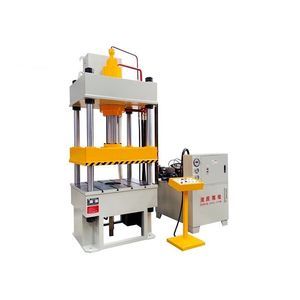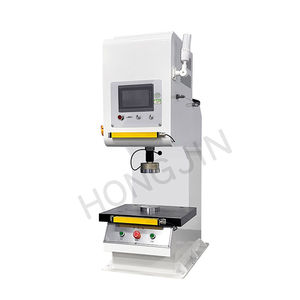
- Production Machines
- Forming Machine
- Hydraulic press
- Dongguan Hongjin Test Instrument Co.,Ltd.
CNC press hydraulicpunchingassembly

Add to favorites
Compare this product
Characteristics
- Operation
- hydraulic
- Function
- stamping, bending, punching, assembly, riveting
- Structure
- column type
- Control
- CNC
- Other characteristics
- custom, hot
- Applications
- process
- Force
100 kN, 1,000 kN
- Opening
70 mm
(3 in)- Rate (strokes/min)
60 p/min
- Stroke
120 mm
(5 in)- Table width
650 mm
(26 in)
Description
CNC presses are also known as bow hydraulic presses, C-type hydraulic presses, single-column hydraulic presses, motors, bearings, motor presses, floor-standing hydraulic presses, auto parts riveting equipment, and hydraulic shaping machines. The CNC hydraulic press adopts the touch screen as data input and data display. The upper and lower limit curves of displacement and pressure can be preset and compared with the current pressing value, and any pressing position can be input to obtain the interference resistance generated by the position during the last pressing. It is suitable for punching of various materials. , stamping, shaping, riveting, bending, shearing, stretching and pressing and assembly of various small parts.
1. Control the press-fitting output of the equipment, and display the current equipment output in real time;
2. Real-time display of the current pressing position in units of 0.01MM;
3. Real-time depiction of the pressing curve of force and displacement;
4. Interference detection can be carried out during the pressing process of parts;
5. The CNC press can compare the final press position to detect whether the press is in place;
6. The rigidity of the product can be tested;
7. It can store the pressing parameters of multiple sets of equipment to facilitate the next use;
8. The press-fitted data can be stored.
Catalogs
No catalogs are available for this product.
See all of Dongguan Hongjin Test Instrument Co.,Ltd.‘s catalogsOther Dongguan Hongjin Test Instrument Co.,Ltd. products
Press mounting machine
Related Searches
- Industrial press
- Hydraulic press
- Forming press
- Automatic press
- Assembly press
- Vertical press
- Pneumatic press
- Punching press
- Electric press
- Manually-controlled press
- Cutting press
- Stamping press
- Bending press
- Four column press
- C-frame press
- Drilling press
- Hot press
- Press for the automotive industry
- Custom press
- Process press
*Prices are pre-tax. They exclude delivery charges and customs duties and do not include additional charges for installation or activation options. Prices are indicative only and may vary by country, with changes to the cost of raw materials and exchange rates.









